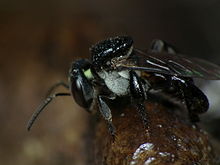
Back Tetragonula carbonaria CEB Tetragonula carbonaria Basque Tetragonula carbonaria French Tetragonula carbonaria Dutch Tetragonula carbonaria Portuguese Tetragonula carbonaria Swedish Tetragonula carbonaria Vietnamese Tetragonula carbonaria WAR
| Tetragonula carbonaria | |
|---|---|

| |
| Scientific classification | |
| Domain: | Eukaryota |
| Kingdom: | Animalia |
| Phylum: | Arthropoda |
| Class: | Insecta |
| Order: | Hymenoptera |
| Family: | Apidae |
| Clade: | Corbiculata |
| Tribe: | Meliponini |
| Genus: | Tetragonula |
| Species: | T. carbonaria
|
| Binomial name | |
| Tetragonula carbonaria Smith, 1854
| |
| Synonyms[1] | |
|
Trigona angophorae Cockerell, T.D.A. 1912 | |
Tetragonula carbonaria (previously known as Trigona carbonaria[2]) is a stingless bee, endemic to the north-east coast of Australia.[3] Its common name is sugarbag bee.[1] They are also occasionally referred to as bush bees. The bee is known to pollinate orchid species, such as Dendrobium lichenastrum, D. toressae, and D. speciosum.[4] It has been identified as an insect that collects pollen from the cycad Cycas media.[5] They are also known for their small body size, reduced wing venation, and highly developed social structure comparable to honey bees.[6]
Tetragonula carbonaria forms honeycombs in their nests.[7] The bee produces an edible honey; the whole nest is sometimes eaten by Indigenous Australians.[8] The bees "mummify" invasive small hive beetles (Aethina tumida) that enter the nest by coating and immobilising the invaders in wax, resin, and mud or soil from the nest.[9]
- ^ a b Dollin, A.; Walker, K.; Heard, T. (2009). "Trigona carbonaria Sugarbag bee". PaDIL (Australian Biosecurity). Archived from the original on 1 April 2012. Retrieved 29 October 2011.
- ^ Smith, Frederick; British Museum (Natural History). Department of Zoology (1854). Catalogue of hymenopterous insects in the collection of the British Museum. Part II. Apidae. Catalogue of hymenopterous insects in the collection of the British Museum. Vol. 2. OCLC 953817942.BHL
- ^ Heard, T.A.; Hendrikz, J.K (1993). "Factors influencing flight activity of colonies of the stingless bee Trigona-Carbonaria (Hymenoptera, Apidae)". Australian Journal of Zoology. 41 (4): 343–353. doi:10.1071/zo9930343.
- ^ van der Cingel, N.A. (2001). An Atlas of Orchid Pollination: Orchids of America, Africa, Asia and Australia. Lisse, Netherlands [etc.]: Swets & Zeitlinger. pp. 231–238. ISBN 978-90-5410-486-5.
- ^ Robert, O. (1991). "Size classes, reproductive behaviour, and insect associates of Cycas media (Cycadaceae) in Australia". Botanical Gazette. 152 (2): 203–207. doi:10.1086/337880. S2CID 84566309.
- ^ Dollin, A.E.; Dollin, L.J.; Sakagami, S.F. (1997). "Australian stingless bees of the genus Trigona (Hymenoptera: Apidae)". Invertebrate Systematics. 11 (6): 861–896. doi:10.1071/it96020.
- ^ Michener, C. (2000). The Bees of the World. Baltimore: Johns Hopkins University Press. p. 800. ISBN 978-0-8018-6133-8.
- ^ Crane, E.E. (1999). The World History of Beekeeping and Honey Hunting. New York: Routledge. p. 89. ISBN 978-0-415-92467-2.
- ^ "Australian bees 'mummify' their beetle enemy alive". BBC News. 17 December 2009. Retrieved 23 December 2009.